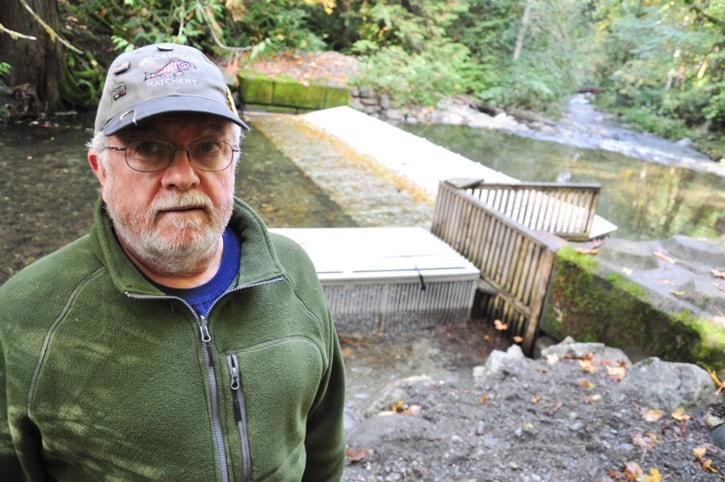The Columbia Fuels gasoline spill looms over Goldstream River’s famed salmon run, but it remains unclear what is trigging low coho and chinook returns so far.
Each morning Goldstream hatchery volunteers are finding only a few salmon, if any, at the japanese weir that funnels returning fish into a cage. By this time last year they counted 333 coho. This year it’s about 60.
The Capital Region watershed started flushing Goldstream River a few weeks ago with an extra 10 million gallons per day to entice fish to enter the spawning grounds, but so far they haven’t taken the bait.
“We know fish are in the inlet. In the past when you release water, you’ll see chinook and early coho,” said Peter McCully, the fish technologist with the Goldstream hatchery. “This year we’re not seeing it.”
Understanding why the run is delayed is more elusive. McCully says April’s fuel spill is just one of a number of factors which could influence the spawning cycle. Predation from growing seal populations in Saanich Inlet, water temperature and salinity and the number of maple leaves falling into the stream can alter the level and timing of fish returns.
“Early indicators are not encouraging at this point,” McCully says. “But the clock hasn’t run out yet. But I am less inclined to think the fuel is having a significant impact.”
Of the 42,000 litres of gasoline and 700 litres of diesel that gushed into Goldstream River on April 16, trace amounts remain. McCully said the ongoing monitoring program has measured “sub lethal” levels of fuel.
“(Fuel) levels are below what is safe for drinking water, and below the minimum requirement for life,” he says. “There is a miniscule amount in the creek.”
Spawning salmon are extremely sensitive to pollutants, but they already face a certain level of hydrocarbons flushed each year off the highway after the first heavy fall rain.
The key test of the river’s health will be the return of thousands of chum salmon, which typically peaks mid-November. Last year the run collapsed after only 4,500 chum returned to the river. In 2009, 19,000 chum made their way to their spawning grounds and 32,000 swam up the river in 2008.
“All the fish are a barometer of health, but the chum are the draw for visitors,” McCully says. “The big selling feature is the chum run.”
Dan Claxton, the fisheries manager for the Tsawout First Nation, surveyed areas of the Saanich Inlet using sonar this week. Fish are out there, but it’s still early in the season.
“There’s not enough water in Goldstream River with all these sunny days,” Claxton said. If we have a few good days of rain, they’ll head up the river. There’s the odd one going up now.”
Tsawout and other First Nations will team up with the Department of Fisheries for a test seine fishery in Saanich Inlet next week. “We’ll get a better idea what’s around,” he said. “It’s too early to be concerned.”
Goldstream cleanup continues
Goldstream River is largely free of gasoline and diesel from April’s spill, but not without overturning a few rocks.
First Nations members involved in the cleanup effort manually raked about 900 square meters of river in September to jostle fuel stuck under stones and gravel. Gasoline breaks down quickly when exposed to sun.
“A survey by First Nations identified areas we they were seeing some sheen, there was some odour,” said Graham Knox, manager of the environmental emergency program with the Ministry of Environment. “They got in there an moved rocks and raked gravel. That freed up the hydrocarbons. It worked very well.”
Environmental contractors working for Columbia Fuels are working on three remaining pockets of fuel near the river – one at the spill site on the highway, and two between the spill site and Finlayson Arm Road in Goldstream park. Even six months later, the odour of gasoline wafts from one of the pockets.
Knox suspects that at the time of the spill, fuel flowed into side channels and became trapped in depressions in the earth. Contractors are sinking wells to delineate the scope of the trapped fuel, and will use a technical system to suck hydrocarbons out of the soil.
Knox said its difficult to know how exactly much fuel is in the ground, but it is above contamination standards.
“It’s very difficult to know how much is there. It could be a vein (of fuel),” he said. “We don’t believe it is a significant amount in the two areas. The potential for the most is at the spill site.”
Monitoring water quality in Goldstream is weekly and ongoing. Columbia Fuels is still working on its proposal for how much compensation it will pay for restoration of the Goldstream ecosystem.
British Columbia doesn’t have a standard formula to generate a dollar amount, so the ministry is asking Columbia to submit a proposal using several models used in the U.S.
Knox said the company will need to provide a rationale for what it proposes to pay. The working group overseeing the cleanup – government agencies, Columbia and its environmental consultants, First Nations and hatchery volunteers – also need to set out restoration goals and priorities.
“It’s got to be a reasonable amount for restoration, and we’ve got to agree what that means,” Knox said. “If that doesn’t work out or if Columbia backs out, then we’ll look at the legislation. We hope to work through consensus and agree on what projects need to be finished.”
editor@goldstreamgazette.com
